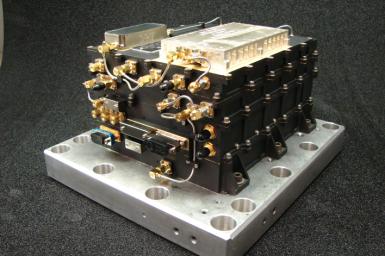
|
Electra Relay Radio on MAVEN Mission to Mars
- Click the image above for a larger view
- Full-Res JPEG (2816 x 1872) (905.7 kB)
- Full-Res TIFF (2816 x 1872) (15.8 MB)
Caption:
NASA's Mars-bound MAVEN spacecraft (for Mars Atmosphere and Volatile Evolution) carries this relay radio transmitter and receiver to be used for UHF (ultra-high frequency) communication with robots on the surface of Mars. It is MAVEN's Electra UHF Transceiver, which passed an in-flight checkout on the spacecraft on Feb. 19, 2014.
Orbiter relay of data from Mars rovers and stationary landers provides return of much more information to Earth than would be possible using only the capability for transmitting data directly from the Mars surface to Earth. NASA's Mars Odyssey orbiter and Mars Reconnaissance Orbiter have provided relay support for the rovers Spirit, Opportunity and Curiosity and for the Phoenix lander. Electra radios, already in use on Mars Reconnaissance Orbiter and Curiosity, are software-defined, enabling them to autonomously adjust their data rate to suit variations in signal strength due to angles and transmission distance as the orbiter crosses the sky over the rover.
This transceiver, the flight model for MAVEN, is about 8.6 inches (22 centimeters) long and 5 inches (13 centimeters) tall. NASA's Jet Propulsion Laboratory, Pasadena, Calif., provided and operates it. MAVEN will be available to provide relay support on a contingency basis during its prime mission and may routinely provide relay support during an extended mission.
MAVEN will examine the upper atmosphere of Mars to provide an understanding about processes that led to the loss of much of the original Martian atmosphere. Data and analysis could tell planetary scientists the history of climate change on the Red Planet and provide further information on the history of planetary habitability. The spacecraft was launched on Nov. 18, 2013, and will enter orbit around Mars in September 2014.
Background Info:
NASA Goddard Space Flight Center in Greenbelt, Md., manages the MAVEN project for NASA's Science Mission Directorate, Washington, and built some of the science instruments for the mission. MAVEN's principal investigator is based at the University of Colorado's Laboratory for Atmospheric and Space Physics in Boulder. The university provided science instruments and leads science operations, as well as education and public outreach, for the mission. Lockheed Martin Space Systems, Denver, built and operates the spacecraft. The University of California at Berkeley's Space Sciences Laboratory provided instruments for the mission. JPL, a division of the California Institute of Technology in Pasadena, provides navigation support and Deep Space Network support, in addition to the Electra hardware and operations.
For more information about MAVEN, visit www.nasa.gov/maven .
Cataloging Keywords:
| Name | Value | Additional Values |
|---|---|---|
| Target | Mars | |
| System | ||
| Target Type | Planet | |
| Mission | Mars Atmosphere and Volatile Evolution (MAVEN) | 2001 Mars Odyssey, Deep Space Network (DSN), Mars Exploration Rover (MER), Mars Reconnaissance Orbiter (MRO), Mars Science Laboratory (MSL), Phoenix |
| Instrument Host | MAVEN | Curiosity Rover, Mars Odyssey, Mars Reconnaissance Orbiter, Opportunity (MER-B), Phoenix Lander, Spirit (MER-A) |
| Host Type | Orbiter | Lander, Rover |
| Instrument | Electra Relay Radio | |
| Detector | ||
| Extra Keywords | Atmosphere, Color, Radio | |
| Acquisition Date | ||
| Release Date | 2014-02-27 | |
| Date in Caption | 2013-11-18 | 2014-02-19 |
| Image Credit | NASA/JPL-Caltech | |
| Source | photojournal.jpl.nasa.gov/catalog/PIA17952 | |
| Identifier | PIA17952 | |
